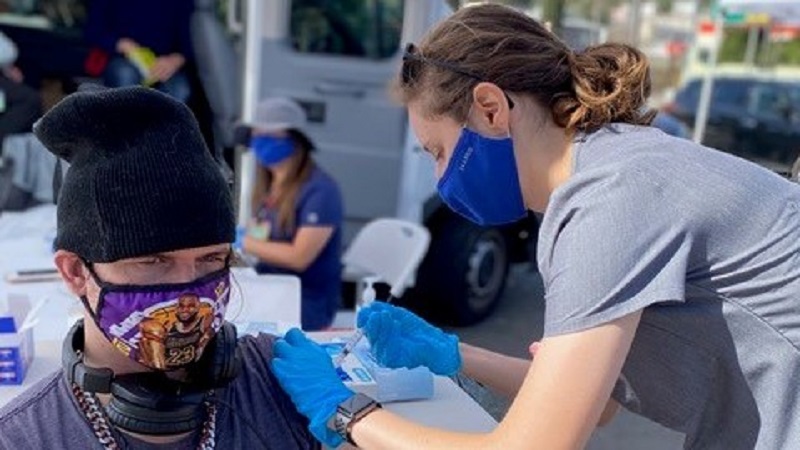*Garrett Toole receives a second dose of the Modern vaccine from Housing for Health EMT Caitlin Molina during an April 9 vaccination event at the Studio City Park and Ride.
The Department of Health Services’ Housing for Health teams have achieved an average 75 percent success rate in giving persons experiencing homelessness their second dose of COVID-19 vaccine, using a multi-faceted strategy of education, encouragement and follow-up.
A division of Los Angeles County’s Department of Health Services, Housing for Health is the central coordinating agency for the county’s COVID vaccination campaign for persons experiencing homelessness.
“We are enormously proud of our personnel who work with expertise and compassion to reach our homeless neighbors, building trust and achieving an impressive success rate in delivering the important second vaccine doses,” said Dr. Heidi Behforouz, medical director of Housing for Health.
Between Feb. 3 – when the vaccination campaign began — and April 6, Housing for Health administered a total of 2,963 first-dose vaccinations to persons experiencing homelessness.
Of the 1,684 individuals who became eligible for their second doses during that period, Housing for Health personnel provided follow-up vaccinations to 1,256 persons experiencing homelessness, achieving a 75 percent success rate.
To improve vaccine engagement, Housing for Health leverages multiple communications including text messages, email reminders, cell phone calls, and alerts in homeless service information systems. Clients who do not have phones are provided one so that the teams can contact them for their second dose.
Additionally, Housing for Health teams staff an after-care telephone call center to ensure that clients have access to nursing support for any questions or concerns with vaccination side effects.
“Housing for Health teams work closely with homeless service agencies to educate people experiencing homelessness and engage them in COVID vaccination,” explained Sarah Mahin, director of Housing for Health. “Our staff fosters trust and offers education and encouragement to overcome vaccine hesitancy.”
Also during the time period of Feb. 3 to April 6, Housing for Health gave a total of 7,340 vaccinations of the Moderna vaccine to 5,082 individuals, including some staff who work with persons experiencing homelessness.
Housing for Health began administering the Johnson & Johnson vaccine April 6 as a single-dose option, while continuing to provide second doses of the Moderna vaccine. Some 238 individuals received the Johnson & Johnson vaccine from Housing for Health April 6-12.
Housing for Health paused administration of the Johnson & Johnson vaccine effective April 13, transitioning to vaccinations with only the Moderna vaccine, pending further directions from the federal Centers for Disease Control and the Food and Drug Administration following reports of unusual blood clots in six women who received the Johnson & Johnson vaccine.
As the central coordinating agency for LA County’s COVID vaccination campaign for people experiencing homelessness, Housing for Health partners with the City of Los Angeles, community clinics, the County Departments of Public Health and Mental Health, Los Angeles Homeless Services Authority (LAHSA), and community organizations to support a hybrid model of clinic and field-based vaccinations for this vulnerable population.
“The collective goal is to offer vaccine to every adult experiencing homelessness,” Mahin said. “Our practice of bringing vaccine to people where they are is essential to vaccinating this population. It is a time- and labor-intensive approach that involves going to hundreds of different locations over time and visiting those locations multiple times.”

